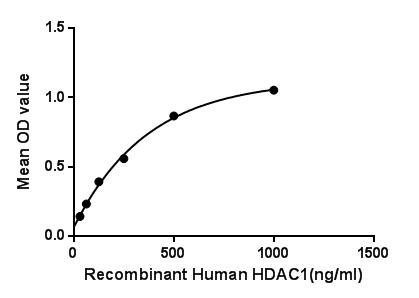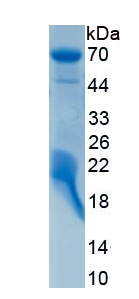Active Histone Deacetylase 1 (HDAC1)
HDAC1; GON10; HD1; RPD3; RPD3L1
- Product No.APC206Hu01
- Organism SpeciesHomo sapiens (Human) Same name, Different species.
- Buffer FormulationPBS, pH7.4, containing 0.01% SKL, 5% Trehalose.
- Traits Freeze-dried powder
- Purity> 90%
- Isoelectric Point5.3
- ApplicationsCell culture; Activity Assays.
- DownloadInstruction Manual
- UOM 10µg50µg 200µg 1mg 5mg
- FOB
US$ 295
US$ 738
US$ 1476
US$ 4428
US$ 11070
For more details, please contact local distributors!
ACTIVITY TEST

Figure. The binding activity of HDAC1 with Sp1.
Histone deacetylase 1 (HDAC1) is an enzyme which belongs to the histone deacetylase/acuc/apha family and is a component of the histone deacetylase complex. Histone acetylation and deacetylation, catalyzed by multisubunit complexes, play a key role in the regulation of eukaryotic gene expression. HDAC1 also interacts with retinoblastoma tumor-suppressor protein and this complex is a key element in the control of cell proliferation and differentiation. Besides, Specificity Protein 1 (Sp1) has been identified as an interactor of HDAC1, thus a binding ELISA assay was conducted to detect the interaction of recombinant human HDAC1 and recombinant human Sp1. Briefly, HDAC1 were diluted serially in PBS, with 0.01% BSA (pH 7.4). Duplicate samples of 100uL were then transferred to Sp1-coated microtiter wells and incubated for 2h at 37℃. Wells were washed with PBST and incubated for 1h with anti-HDAC1 pAb, then aspirated and washed 3 times. After incubation with HRP labelled secondary antibody, wells were aspirated and washed 3 times. With the addition of substrate solution, wells were incubated 15-25 minutes at 37℃. Finally, add 50µL stop solution to the wells and read at 450nm immediately. The binding activity of of HDAC1 and Sp1 was shown in Figure 1, and this effect was in a dose dependent manner.
USAGE
Reconstitute in 10mM PBS (pH7.4) to a concentration of 0.1-1.0 mg/mL. Do not vortex.
STORAGE
Avoid repeated freeze/thaw cycles. Store at 2-8°C for one month. Aliquot and store at -80°C for 12 months.
STABILITY
The thermal stability is described by the loss rate. The loss rate was determined by accelerated thermal degradation test, that is, incubate the protein at 37°C for 48h, and no obvious degradation and precipitation were observed. The loss rate is less than 5% within the expiration date under appropriate storage condition.
GIVEAWAYS
INCREMENT SERVICES
-
 BCA Protein Quantification Kit
BCA Protein Quantification Kit
-
 Molecular Mass Marker for Protein
Molecular Mass Marker for Protein
-
 Monoclonal Antibody Customized Service
Monoclonal Antibody Customized Service
-
 Polyclonal Antibody Customized Service
Polyclonal Antibody Customized Service
-
 Protein Activity Test Experiment Service
Protein Activity Test Experiment Service
-
 Electrophoretic Mobility Shift Assay (EMSA) Experiment Service
Electrophoretic Mobility Shift Assay (EMSA) Experiment Service
-
 Buffer
Buffer
-
 Lentivirus Packaging Experiment Service
Lentivirus Packaging Experiment Service
-
 Adenovirus Packaging Experiment Service
Adenovirus Packaging Experiment Service
-
 Real Time PCR Experimental Service
Real Time PCR Experimental Service
-
 Spike RBD Protein (S-RBD)
Spike RBD Protein (S-RBD)
-
 Protein G
Protein G
-
 Protein A
Protein A
| Magazine | Citations |
| Journal of Integrative Medicine | Saponins isolated from roots of Chlorophytum borivilianum reduce acute and chronic inflammation and histone deacetylase Pubmed:25609369 |
| Tzu Chi Medical Journal | Effects of tetrandrine and caffeine on cell viability and expression of mammalian target of rapamycin, phosphatase and tensin homolog, histone deacetylase 1, and histone acetyltransferase in glioma cells Science: Article |
| Restor Neurol Neurosci | Uridine protects against hypoxic-ischemic brain injury by reducing histone deacetylase activity in neonatal rats PubMed: 26410212 |
| Pharmacol Biochem Behav | Lacosamide reduces HDAC levels in the brain and improves memory: Potential for treatment of Alzheimer's disease PubMed: 25931268 |
| 网页打不开 | Effects of caffeine on cell viability and activity of histone deacetylase 1 and histone acetyltransferase in glioma cells S1016319016300295 |









